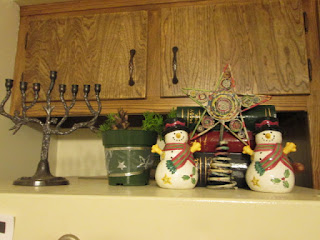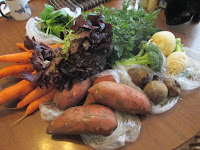As usual, Brian and I are spending Christmas week in Indiana with his family, away from our house and our garden. But we've also stuck with the tradition we started last year of bringing the
Fedco seed catalogue with us, so we can discuss this year's garden and choose crops for next year.
This year, some crops did very well, others very poorly—and they weren't necessarily the same crops that performed well or poorly in the past. So I'm going to do this post in the style of the "hits and misses" column in the paper, outlining our garden's successes and failures of 2015 and what we intend to do about them in 2016.
HIT: The arugula, which gave us only a modest crop in the spring, but then reseeded itself (partly in the bed where it was planted, partly in the paths between the beds) to provide a much more ample crop in the fall. In fact, the fall crop of arugula is still producing, even after several hard frosts, and probably will keep going until either we eat it all or the ground freezes solid.
To do: Replenish our stock of this variety (Rocket OG) for next year.
HIT: The basil, which once again produced a
monster crop this year thanks to our "carpet sowing" method. We have stored enough, both in frozen cubes and packed in oil, to get us through the winter easily (especially since we still have a tiny bit of our 2014 crop left).
To do: Replenish our stock of this variety (Sweet Basil OG) and stick with the "carpet sowing" method.
MISS: The broccolini, a new crop that we tried for the first time this year. We'd had no success growing standard broccoli, but we hoped that the broccolini might prove easier to grow and possibly tastier as well. But alas, like the head broccoli, it produced only a few little, scrawny stalks.
To do: Drop the broccolini as a crop and instead take another crack at growing eggplant, a veggie we go through quite a lot of since we discovered/invented our recipe for
eggplant and string beans in garlic sauce. Our previous attempts to grow eggplant were miserable failures; first the
squirrels pulled the fruits off before they got larger than thumb-sized, and then, after Brian invented his
squirrel excluder to keep them out, the seedlings we started were so scrawny that they never produced any decent-sized fruits. But Brian thinks our new
seed starting method, which combines sterilized garden soil with potting mix, may succeed in producing large enough plants to give us decent-sized fruits. So we're planning to buy some of the Pingtung variety, a long Chinese-style eggplant that's supposed to be vigorous and reasonably high-yielding.
 MISS:
MISS: The Brussels sprouts. We made a point of starting them early this year, and the plants got nice and big and leafy...but the actual sprouts, the part you eat, still haven't grown big enough to harvest. On the plus side, the plants still seem to be healthy even despite the near-freezing temperatures, so we figure we'll just leave them out there in the garden until they either die or provide edible sprouts. If they're still alive in the spring, we'll just let them stay put.
To do: Seeing as how we did manage to get some actual sprouts on the plants this year, we figure it's worth one more try to see if we can get any that are big enough to make a nice batch of
roasted Brussels sprouts. This time, we're planning to try removing the lower leaves from the plant, which is supposed to encourage the sprouts to grow bigger. If that still doesn't give us a decent harvest, I think we'll just give up on this crop and resign ourselves to buying our sprouts at the store.
MISS: The cucumbers. Although both varieties we planted this year, the Marketmore and the Calypso, are listed in the catalogue as "tolerant to PM" (powdery mildew), both sets of vines were pretty badly infected with it this year, as were all our other squash plants. We still got a modest crop off them, but not nearly as many as we were anticipating, considering the absurdly huge harvest we got in 2014.
To do: Don't ditch the remaining Calypso and Marketmore seeds we have, but do add a new variety, Cross Country, which is described as actually "resistant to PM" rather than merely "tolerant."
HIT: The green beans, a bush variety called Provider OG that gave us a pretty decent harvest—enough for a few meals—in only three squares of space.
To do: Check our stock of these seeds, and buy more if needed.
HIT: The leeks, which produced plenty of healthy, decent-sized plants.
To do: Check our stock of this variety (Lincoln), and buy more if needed.
MISS: The lettuce. We planted three varieties of lettuce this year: the Summer Mix we grew last year, a new variety called Blushed Butter Oaks that was supposed to be an early producer, and a cold-hardy variety called Winter Marvel that could allegedly keep producing all winter long. Unfortunately, none of these gave us much of a crop. The Blushed Butter Oaks produced almost nothing; the Summer Mix gave us a few scattered leaves throughout the summer; and the Winter Marvel has yet to yield a significant amount—though it is still growing, so I guess there's hope for the winter.
To do: Let the Winter Marvel overwinter and see how it does before deciding whether it's worth planting more next year. In the spring, we'll try going back to a butterhead variety—perhaps the Tom Thumb we've grown successfully in the past, or maybe a new one like Bronze Mignonette. But since we can't count on a good crop of lettuce with any of these varieties, we'll devote less space to it next year—maybe just three or four squares—and plant the rest with New Zealand spinach. (We bought some of this last year, planning to plant it in the side yard, and then forgot to do it, so we'll try it in the garden next year and hope it's still good.)
MIXED: The lima beans. The vines grew to huge size and looked really impressive, but we didn't actually get that much edible material off them.
To do: Go ahead and plant them again next year. They didn't give us that much food, but they didn't take up that much space, either, since they grew entirely on trellises—and Brian says he finds it very satisfying to see at least one set of really big, green, thriving plants in the garden.
HIT: Our new Vanilla marigolds, which bloomed clear into November and supplied us with lots of beautiful blossoms for the table (though unfortunately we had to keep them
under glass so the kitties wouldn't eat them). I couldn't tell whether they actually did anything to keep bugs off the tomatoes, as marigolds are supposed to do, but they sure looked nice.
To do: Go ahead and buy some more of these. At $1.30 for a tiny little packet, they're a bit pricier than some of our other crops, but they're still way cheaper than buying fresh-cut flowers.
MISS: The peppers. Since we've had such terrible luck with pepper seedlings in the past, we decided not to start any peppers at all this year, but to buy four plants at the Rutgers plant sale. Two of these, a jalapeno and a frying pepper called Mamma Mia Giallo, did okay, but both the bell peppers—Staddons Select and Chocolate Beauty—failed miserably, producing maybe one or two edible peppers apiece.
To do: Since bell peppers never seem to do well in our yard no matter what we do, we're not bothering with them at all next year. And since we already have plenty of jalapenos in the freezer, we shouldn't need to grow more of those next year either. So we're going to buy another frying pepper (the Jimmy Nardello variety we've tried with moderate success in the past) and make another attempt to order the highly touted
Klari Baby Cheese pepper, making absolutely sure to say NO SUBSTITUTIONS on the order form this time. Then we'll start these with our new seed-starting method and see whether the resulting plants are healthy enough to go out in the garden without being mistaken for worms by hungry birds.
HIT: The scallions. Our generic white scallion seeds, carpet sown across four squares, kept us in scallions all summer long.
To do: Check our stock of these seeds and replenish as needed.
HIT: Our new Cascadia snap peas, which gave us a plentiful crop that lasted well into June.
To do: Continue to devote one full trellis to this crop next year (and continue to start them as early as possible).
MIXED: The butternut squash. We grew two varieties this year, the fast-ripening Ponca Baby and the larger Waltham OG, and neither one gave us all that many squash. Moreover, some of the Walthams didn't ripen fully before the frost hit and we had to pick them all.
To do: After searching the catalogue, we couldn't find another variety that was both good-sized and fast-growing, so we're planning to continue planting both of these next year. That way we can hope to get some larger squash, while still being sure of some that will have a chance to ripen fully.
MIXED: The tomatoes. We grew four varieties this year:
- our usual highly productive Sun Golds;
- a new mid-season variety called Black Prince OG, which was moderately productive;
- Amish Paste, which didn't give us that many overall, but kept going longer into the fall than the others; and
- Moskvitch, an early-season plant we bought at the Rutgers plant sale, which didn't actually produce much of anything.
To do: Stick with the first three, but try to find a new early-season tomato that we can start ourselves. With our new seed-starting method, we figure we have a good chance of producing a vigorous enough plant to actually give us an early crop. We've got our eye on a variety called Glacier, which ripens in a mere 56 days and is highly cold-tolerant.
 HIT:
HIT: The zucchini. Even though we lost one of our two plants to squash vine borers and the other suffered badly from powdery mildew, we still managed to get a reasonably
plentiful crop.
To do: Stick with the Raven variety we grew this year. We considered trying a new one called Sebring that's supposed to resist powdery mildew, but there's no such thing as a zucchini plant that can resist borers, and we can't be sure the Sebring's overall production will match the Raven. So we're keeping the bird in the hand.
So those are our plants for our 2016 garden. As soon as we get home, we'll check our existing seed supply and place our order with Fedco, so we have as good a chance as possible of getting everything on our list. Stay tuned to hear more about our new crops in February, when the Festival of Seeds rolls around.
























